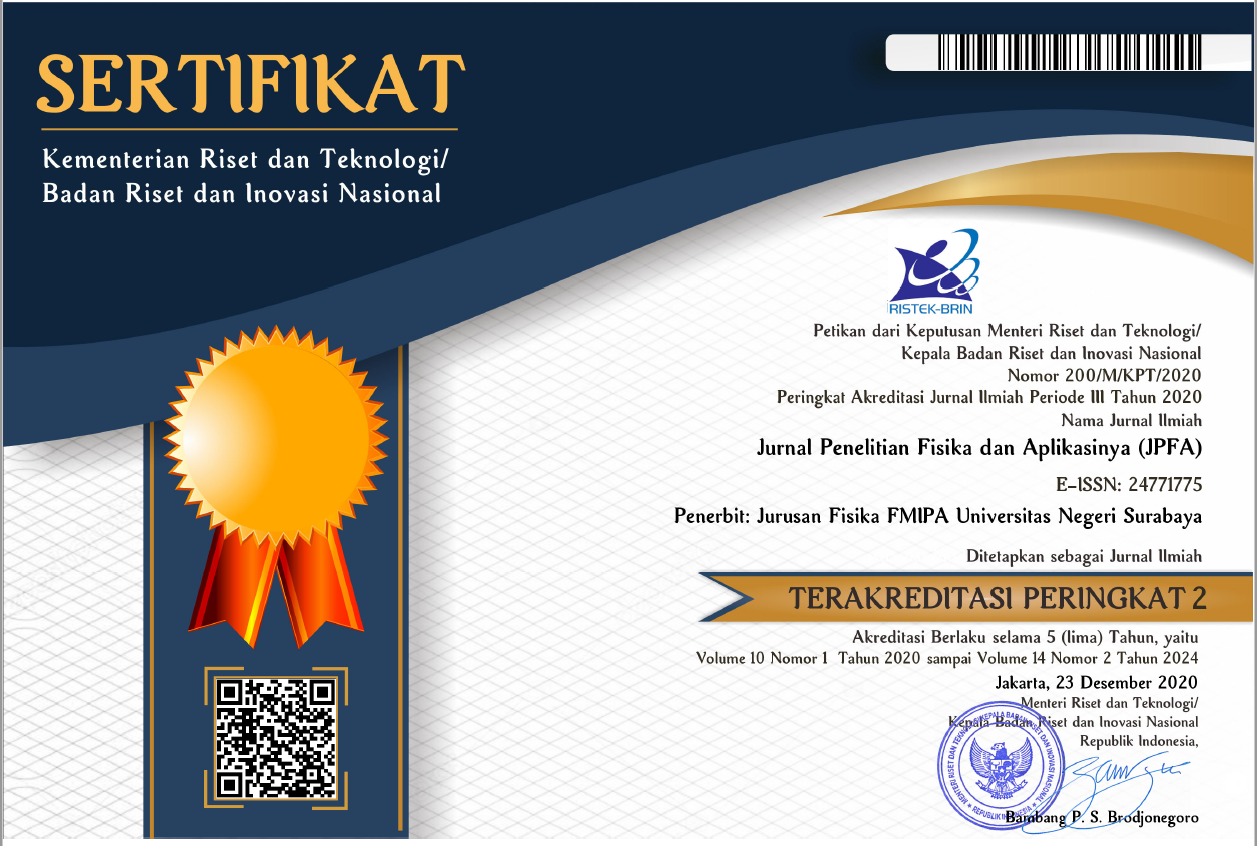STUDI MODEL ALIRAN FLUIDA DAN PERPINDAHAN PANAS PADA PBMR
DOI:
https://doi.org/10.26740/jpfa.v3n2.p28-36Keywords:
Aliran fluida, perpindahan panas, PBMR, packed bed, penurunan tekananAbstract
Reaktor tipe Pebble bed merupakan opsi yang menjanjikan untuk teknologi reaktor generasi mendatang dan memiliki potensi untuk memberikan pembangkitan listrik dengan efisiensi tinggi dan murah.Perpindahan panas reaktor ini menghadapi kendala akibat kompleksitas yang berkaitan dengan desain aliran panas.Dengan demikian, untuk mensimulasikan secara baik aliran dan perpindahan panas reaktor modular pebble bed ini memerlukan suatu model perpindahan panas yang berhubungan dengan radiasi serta konveksi dan konduksi panas.Dalam studi ini, suatu model dengan kemampuan untuk mensimulasikan aliran fluida dan perpindahan panas dalam teras reaktor modular pebble bed telah dikembangkan.Model ini diterapkan pada suatu personal computer (PC) yang menggunakan program komputer Matlab r2008a Versi 7.1.Beberapa parameter penting aliran fluida dan perpindahan panas telah dipelajari, termasuk penurunan tekanan (pressure drop) di teras reaktor, koefisien perpindahan panas, bilangan Nusselt, dan konduktivitas panas efektif pebble bahan bakar. Hasil yang diperoleh dari percobaan simulasi menunjukkan adanya suatu tekanan yang merata pada arah radial untuk suatu rasio diameter teras terhadap elemen bakar (D/d) > 20 dan koefisien perpindahan panas meningkat seiring dengan peningkatan temperatur dan laju alir massa pendingin. Model ini dapat menjelaskan secara memadai fenomena aliran panas dan perpindahan panas dan kehilangan tekanan melalui friksi dalam PBMR tipe pebble bed.References
Du Toit. C.G., The numerical determination of the variation in the porosity of the pebble bed core. Proc. Top1 Mtg. High Temperature Reactor Technology (HTR-TM). April 22-24, 2002.
Achenbach, E., œHeat and fluid flow characteristics of packed Beds. Exp. Therm. Fluid Sci., 10: 17-27, 1995
Pieter, J.V. and N.M.Mark, œIntegrated design approach of the pebble bed modular reactor using models. Nuclear Eng.Des. 237:1341-1353, 2007. 4
Achenbach, E., œHelium Cooled Systems, HTR-Pebble Bed Design, Pergamon Press Inc., New York. Pp: 381-405, 1981
KTA.S.,Reactor core design of High Temperature Gas-Cooled Reactors. Nuclear Safety Standards Commision. KTA standars 3102.1.3102.2.3102.3, 1978, 1981, 1983.
IAEA TECDOC-1163, œHeat Transport and After Heat Removal for Gas Cooled Reactors Under Accident Conditions International Atomic Energ Agency,2000.
Breitbach. G. And H. Barthels., The radiation heat transfer in the HTR core after failure of the afterheat removal system,. Nuclear Technol., 49:392-399, 1980
Bauer, R. And E.U. Schluender, œEffective radial thermal conductivity ofPackings in gas flow Part 2: Thermal conductivity of the packing fraction withoutGas flow. Inter. Chem. Eng., 18: 189-204,1978.
Yanhua. Z., S. Lei and D.Yujie.,Thermohydraulic transient studies of the Chinese 200 MWE HTR-PM for loss of forced cooling accidents. Ann.
Downloads
Published
How to Cite
Issue
Section
License
Author(s) who wish to publish with this journal should agree to the following terms:
- Author(s) retain copyright and grant the journal right of first publication with the work simultaneously licensed under a Creative Commons Attribution-Non Commercial 4.0 License (CC BY-NC) that allows others to share the work with an acknowledgement of the work's authorship and initial publication in this journal for noncommercial purposes.
- Author(s) are able to enter into separate, additional contractual arrangements for the non-exclusive distribution of the journal's published version of the work (e.g., post it to an institutional repository or publish it in a book), with an acknowledgement of its initial publication in this journal.
The publisher publish and distribute the Article with the copyright notice to the JPFA with the article license CC-BY-NC 4.0.
 Abstract views: 1438
,
Abstract views: 1438
, PDF Downloads: 1058
PDF Downloads: 1058








